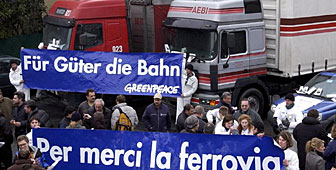Italian truckers bring chaos to Swiss-Italian border

Hundreds of trucks spent Wednesday in waiting areas on either side of the Swiss-Italian border as Italian hauliers staged a blockade to protest against Switzerland's policy on alpine traffic.
Their protest, which began at 5am on Wednesday morning, lasted 12 hours. It was initially pencilled to carry on until 10pm but was called off at 5pm on Wednesday afternoon.
During the day, there was a ten-kilometre-stretch of protesters in vehicles on the Italian side of the Chiasso border crossing. On the Swiss side, drivers were advised to stay in holding areas in Ticino and Central Switzerland until the protest was over.
By late Wednesday morning more than three hundred trucks had congregated in the Ticinese holding areas while hundreds more could be counted in cantons Uri and Lucerne.
Surprisingly, domestic traffic and private vehicles were able to use the crossing with relative ease, thanks in part to the federal government’s emergency measures.
In canton Graubünden on the busy A13 access road over the San Bernadino pass, traffic flowed as normal, but all heavy goods vehicles were pulled off the road. Cantonal police only allowed private vehicles and empty goods trucks to use the north-south route. Hauliers had to pull over and wait for the blockade to end in special holding areas.
FAI behind the protest
The Italian Road Hauliers Association (FAI), which is behind the protest, prevented truck traffic from entering Switzerland in a bid to pressure the Italian government to intervene against Swiss transport policy.
The Italian truckers have asked Switzerland to lift its restrictions on foreign cargo traffic. This would include re-establishing heavy goods traffic in both directions through the Gotthard tunnel, and allowing trucks to transit 24 hours a day through Switzerland. They also want an improvement in the infrastructure of the roads.
Safety measures, including limiting truck traffic to a single direction at a time through the Gotthard tunnel, were stepped up in Switzerland after two trucks collided in the tunnel last October, triggering a blaze that killed 11 people.
Since the restrictions were implemented, the number of trucks going through the tunnel has dropped to 3,000 a day, instead of the previous 5,000. This has caused lengthy delays in special waiting areas, and a sharp increase in transportation costs.
More action possible
The FAI has warned that this could be the start of numerous actions if the trucker’s demands are not taken seriously.
It affected the Chiasso and Gaggiolo border controls in canton Ticino, roads leading into canton Valais and mountain passes such as the Fréjus in France and the Brenner in Austria.
“Every day, drivers travelling across Europe face hour-long delays in Switzerland,” Giorgio Colato, head of the FAI, said before the blockade went into effect. “We’ll be blocking roads to show the consequences of Switzerland’s policy towards international traffic.”
Swiss truckers not involved
Truckers in Switzerland said they would not support their Italian counterparts.
“Blockades and demonstrations of this kind work against Swiss importers and exporters’ interests,” Carlo Schmid, head of the Swiss Hauliers’ Association, told swissinfo. “Truck drivers transiting to and through Italy would be prevented from doing their work.”
“This is why we do not support the FAI’s initiative.”
The association, however, does not fully support the Swiss government’s decisions regarding cargo traffic. In a recent meeting, it discussed the possibility of no longer paying the heavy cargo road tax.
An attentive ear
The Swiss government has been attentive to comments made by the hauliers’ association. It decided on Monday to allow up to 3,500 trucks to cross the Gotthard tunnel, instead of the current 3,000, but has given security top priority.
“We are studying ways of helping indigenous traffic,” said the spokesman for the Federal Roads Authority, Michael Gehrken. “Foreign drivers have alternative routes, but Swiss drivers don’t necessarily have that choice.”
by Marzio Pescia, Jeff Nottage and Sally Mules

In compliance with the JTI standards
More: SWI swissinfo.ch certified by the Journalism Trust Initiative
You can find an overview of ongoing debates with our journalists here . Please join us!
If you want to start a conversation about a topic raised in this article or want to report factual errors, email us at english@swissinfo.ch.